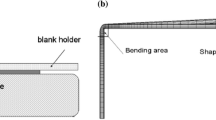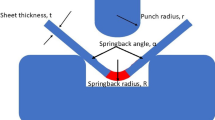Abstract
The current work involves both modeling and optimization approaches to achieve minimum spring-back in V-die bending process of heat treated CK67 sheets. Number of 36 experimental tests have been conducted with various levels of sheet orientation, punch tip radius and sheet thickness. Firstly, various predictive models based on statistical analysis, back-propagation neural network (BPNN), counter propagation neural network (CPNN) and radial basis function network (RBFNN) have been developed using experimental observations. Then the accuracy of the developed models has been compared based on values of mean absolute error (MAE), and root mean square error (RMSE). Secondly, the model with lowest values of MAE, and RMSE has been applied as objective function for optimization of process using imperialist competitive algorithm (ICA). After selection of optimal bending parameters, a confirmation test has been conducted to prove the optimal solutions. Results indicated that the radial basis network fulfills precise prediction of process rather than the other developed models. Also, confirmation tests proved that both RBFNN and ICA could predict and optimize the process vigorously.







Similar content being viewed by others
References
Kalpakjian S, Schmid SR (2001) Manufacturing engineering and technology, Ch. 16. Prentice-Hall, Upper Saddle River
Schuler GH (1998) Metal forming handbook, Ch. 4. Springer-Verlag, Berlin
Lange K (1985) Handbook of metal forming, Ch. 1. McGraw-Hill, New York
Thipprakmas S, Rojananan S (2008) Investigation of negative spring-go phenomenon using finite element method. Mater Des 29:1526–1532
Tekiner Z (2004) An experimental study of the examination of springback of sheet metals with several thicknesses and properties in bending dies. J Mater Process Technol 145:109–117
Moon YH, Kang SS, Cho JR, Kim TG (2003) Effect of tool temperature on the reduction of the springback of aluminium sheets. J Mater Process Technol 132:365–368
Li X, Yang Y, Wang Y, Bao J, Li S (2002) Effect of the material-hardening mode on the springback simulation accuracy of V-free bending. J Mater Process Technol 123:209–211
Cho JR, Moon SJ, Moon YH, Kang SS (2003) Finite element investigation on springback characteristics in sheet metal U-die bending process. J Mater Process Technol 141:109–116
Gomes C, Onipede O, Lovell M (2005) Investigation of springback in high strength anisotropic steels. J Mater Process Technol 159:91–98
Bozdemir M, Gulcu M (2008) Artificial neural network analysis of springback in V bending. J Appl Sci 8(17):3038–3043
Liu W, Liu Q, Ruan F, Liang Z, Qiu H (2007) Springback prediction for sheet metal forming based on GA–ANN technology. J Mater Process Technol 187:227–231
Ruffini R, Cao J (1998) Using neural network for springback minimization in a channel forming process. Dev Sheet Metal Stamping 1322:77–85
Pathak KK, Panthi S, Ramakrishnan N (2005) Application of neural network in sheet metal bending process. Def Sci J 55:125–131
Forcellese A, Gabriella F (2001) Artificial neural-network-based control system for springback compensation in press-brake forming. Int J Mater Prod Technol 16:545–563
Inamdar M, Narasimhan K, Maiti SK, Singh UP (2000) Development of an artificial neural network to predict spring-back in air vee bending. Int J Adv Manuf Technol 16:376–381
Viswanathan V, Kinsey B, Cao J (2003) Experimental implementation of neural network spring-back control for sheet metal forming. J Eng Mater Technol 125:141
Cao J, Kinsey B, Solla SA (2000) Consistent and minimal springback using a stepped binder force trajectory and neural network control. J Eng Mater Technol 122:113–118
Kazan R, Fırat M, Tiryaki AE (2009) Prediction of spring-back in wipe-bending process of sheet metal using neural network. Mater Des 30:418–423
Rahmani B, Alinejad G, Bakhshi-Jooybari M, Gorji A (2010) An investigation on spring-back/negative spring-back phenomena using finite element method and experimental approach. Proc IME B J Eng Manufact 223:841–850
Atashpaz-Gargari E, Lucas C (2007) Imperialist competitive algorithm: an algorithm for optimization inspired by imperialistic competition. IEEE Congr Evol Comput CEC 2007:4661–4667
Atashpaz-Gargari E, Hashemzadeh F, Rajabioun R, Lucas C (2008) Colonial competitive algorithm: a novel approach for PID controller design in MIMO distillation column process. Int J Intell Comput Cybernet 3(1):337–355
Kaveh A, Talatahari S (2010) Optimum design of skeletal structures using imperialist competitive algorithm. Comput Struct 88:1220–1229
Kaveh A, Talatahari S (2010) Imperialist competitive algorithm for engineering design problems. Asian J Civil Eng 11(6):675–697
Wilson F (1965) ASTME Die design handbook, 2nd edn. McGraw-Hill, New York
Marciniak Z, Duncan JL, Hu SJ (2002) Mechanics of sheet metal forming. Butterworth-Heinemann, Oxford
Hagan MT, Demuth HB, Beale M (1996) Neural network design. PWS Publishing Company, Boston
Nielsen RH (1987) Counter propagation networks. Appl Optics 26:4979–4985
Yang SH, Srinivas J, Mohan S, Lee DM, Blajee S (2009) Optimization of electric discharge machining using simulated annealing. J Mater Process Technol 2094471-4475
Joshi SN, Pande SS (2011) Intelligent process modelling and optimization of die-sinking electric discharge machining. Appl Soft Comput 11:2743–2755
Author information
Authors and Affiliations
Corresponding author
Rights and permissions
About this article
Cite this article
Teimouri, R., Baseri, H., Rahmani, B. et al. Modeling and optimization of spring-back in bending process using multiple regression analysis and neural computation. Int J Mater Form 7, 167–178 (2014). https://doi.org/10.1007/s12289-012-1117-4
Received:
Accepted:
Published:
Issue Date:
DOI: https://doi.org/10.1007/s12289-012-1117-4




